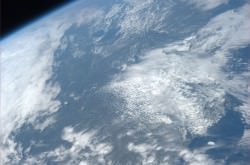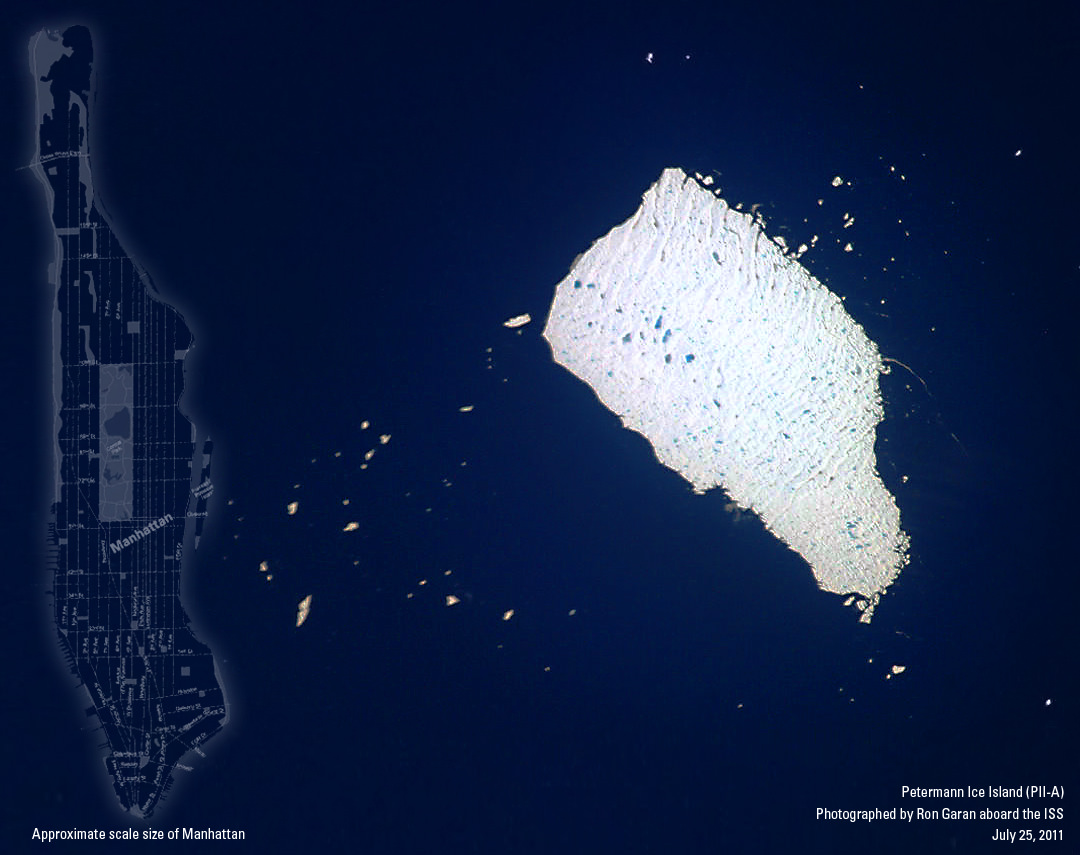[/caption]
Taken by NASA astronaut and Expedition 27 flight engineer Ron Garan, this image shows the Petermann Ice Island (PII-A) currently adrift off the coast of Labrador. The island is a chunk of ice that broke off the Petermann Glacier in Greenland in August of 2010 and has been moving slowly southward ever since. It is currently about 21 square miles (55 square km) in size – nearly the same area as Manhattan!
Garan’s original photo was posted to his Twitter feed earlier today… I cropped the full-size version, rotated it so that south is down and edited it to bring out surface details in the island. Ridges in its surface can be seen as well as many bright blue meltwater ponds.

Overlaid on the left side is an approximate scale size of Manhattan. This thing is BIG!
PII-A is currently drifting toward Newfoundland but is unlikely to reach land… its base will run against the sea floor long before that. But it has been reported to be posing a problem for ships and offshore oil rigs. (Read more about PII-A on NASA’s Earth Observatory site here.)
When he’s not performing other duties aboard the Space Station, Ron Garan posts photos of Earth from orbit on his Twitter feed (@Astro_Ron) and also on his website FragileOasis.org, thereby sharing his unique and privileged perspective on our world. Founded by Garan, Fragile Oasis is a site that supports and publicizes many global projects supporting humanitarian and environmental missions. Visit, become a member, and you too can “learn, act, and make a difference.” After all, who better than an astronaut would know how much our world is connected, and how fragile it really is!
Image credit: NASA / Ron Garan. Edited by Jason Major.
PS: If you want an idea of how something like this would look like up close, check out this video below taken from a ship near one of the smaller pieces of the ice island!
_______________________
Jason Major is a graphic designer, photo enthusiast and space blogger. Visit his website Lights in the Dark and follow him on Twitter @JPMajor or on Facebook for the most up-to-date astronomy awesomeness!


Any chance we could tow it to the Horn of Africa?
Hey Silicon I was writing my post before I saw yours! Simultanious occurance of ideas, coincidence or cosmic resonance? Or did you read mine before you wrote it? I edited mine a few minutes after my first version, so it was placed after yours?
Anyway, I think the iceberg will melt if it has to go all the way around Africa to Somalia etc. Perhaps if a big chunk breaks off of the Antarctic ice sheet…
Great minds and all that. I didn’t see any comments when I posted.
I was half being snarky, but I recall hearing the idea aired years ago.
If it was viable, I suspect the Gulf states would have already implemented it.
I doubt it’s feasible to make sails and rudders sufficiently big and sturdy for the job.
Sadly.
Maneuverability, scale of the project, and IIRC the problem that it would take more energy and investment to do that than to desalinate sea water (coastal water access assumed in any case).
But I may remember wrong on that last point, so you should check me on that.
I wonder if a big iceberg like this could be towed towards the shore of an arid land to be used as fresh water supply. This one probably could have brought a large amount of ice to the western coast of the Sahara desert if it would have been towed right after it broke off last year, when it was 5 times the size it is now.
Thank you so much for posting and sharing this. Since yesterday this ice island has moved offshore and to the south … what matters most is not the distance to the coast, but what the water depth is and how the bottom slopes. This island has been close to the Canadian shores for at least the last 300 days. All this is for wonderful science reasons that I explain along with todays and yesterdays satellite data at http://icyseas.wordpress.com/2011/07/26/petermann-ice-island-seen-from-international-space-station/ … this is so much fun.
Interesting info in that article, Andreas! Thanks!
This is a big case of the Greenland ice sheet spalling. As arctic temperatures warm there is more water flow under ice sheets which undermines their structural integrity. Eventually they slough off of the land mass. A lot of people don’t like the idea, but this does have something to do with our species penchant for producing CO_2.
There were ideas about towing icebergs to the coasts as fresh water sources. It is likely this ice behemoth is too much to tow. I doubt we have ships capable of resisting the ocean currents.
LC
Besides the climate implications of an observably increased ice melting rate, these are wondrous biotopes.
Icebergs are hotspots of life, especially on the underside I think. They feed nutrients to the water.
Actually much larger chunks have broken off in the Antarctic and there have been considerations of using them as fresh water supply for poor countries in the southern hemisphere. Feasiblity studies have not produced convincing results, however. You have to consider that the natural drift in the sea can be quite powerful although you may not notice this. Trying to tow such a large icebergs against the direction of the currents in the sea is a vain effort. So you cannot be sure of actually arriving at the place where you would like to have the iceberg.
Though I love that contribution by @JPMajor the comparison of sizes is NOT to scale.On July 25, the date of the iceberg pic, it was about 18 square miles (6.08 by 3.01 miles) which can be measured when comparing it to features at the coast near Petty Harbour. The value of 21 sq mi is from the Canadian Ice Service of July 8.
Manhattan Island north-south measures 10.5 miles. Maintaining the overall image size the iceberg is too large. I have made such a comparison of the true size of the iceberg, as overlay of the above pic, making you see the difference. It is posted here: http://yfrog.com/kezmt2j
It’s wild to think that there is a chunk of ice the size of Manhattan floating around in the ocean. Is this a hazard at all, or will it eventually melt/break up into smaller pieces? We wouldn’t want it making contact with any coastal cities!